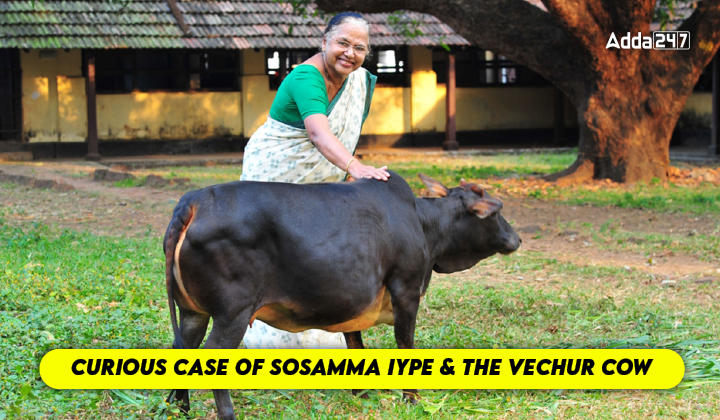Table of Contents
An article in The Hindu newspaper tells the remarkable tale of a modest woman who was honored with the Padma Shri in 2022 for an extraordinary achievement: the revival and preservation of a native cattle breed, the Vechur cow. The narrative of Dr. Sosamma Iype is emblematic of India’s struggle to balance rapid industrialization with the conservation of its rich biodiversity, during a period when the push for modernization overshadowed environmental concerns.
Relevance: GS III (Environment & Science)
Background
Post-independence India faced severe poverty and food scarcity. This led to the establishment of agricultural universities and initiatives like the Green and white Revolutions, aimed at increasing agricultural and dairy production respectively.
Despite the successes of these revolutions in boosting production, they had significant negative impacts on indigenous breeds of livestock. The Vechur cow, one of the world’s smallest cattle breeds, became nearly extinct due to the preference for high-yielding foreign breeds.
Dr. Sosamma Iype realized that the Vechur breed had all but disappeared from official records and was considered extinct.
A turning point came when Anil Zachariah, one of Dr. Iype’s students, discovered a Vechur cow in Kerela. This discovery reignited Dr. Iype’s hope and commitment to saving the breed.
Dr. Iype founded the Vechur Conservation Unit at the Kerala Agricultural University with just eight cows.
The Success of the Vechur Conservation Project eventually gained recognition beyond Kerala, with national institutions like the Indian Council of Agricultural Research (ICAR) adopting it as a model for conservation across India.
Dr. Iype also founded the Vechur Conservation Trust to promote community participation and support destitute farmers by providing them with Vechur Cattle.
India’s Indigenous Bovine Breeds
- Total of 50 (37 cattle and 13 buffalo breeds).
- Milch Breeds: Primarily for milk – e.g., Sahiwal, Gir, Red Sindhi.
- Dual-Purpose Breeds: For milk and labor – e.g., Kankrej, Ongole.
Unique Features
- Hump: Aids in load-bearing, absent in foreign breeds.
- Dewlap: Provides heat resistance, prominent in local breeds.
- Dung: Versatile use in agriculture and medicine, unlike that of foreign breeds.
Advantages of Indigenous Over Exotic Breeds
- Cost-Effective: Lower purchase and upkeep costs.
- Climate Resilient: Better suited to Indian conditions.
- Disease Resistant: Less prone to common livestock diseases.
- Sustainable Production: Consistent output over time.
- Eco-Friendly: Lower methane emissions.
- Supports Small Farmers: Accessible to those with limited resources.
- Cultural Integration: Integral to various local practices.
- Challenges Facing Indigenous Breeds:
- Lower Milk Yields: Compared to high-yielding exotic breeds.
- Technological Gap: Affects breed improvement and productivity.
- Changing Preferences: Affects demand for indigenous breed products.
- Population Decline: Some breeds nearing extinction.
- Limited Germplasm Availability: For comprehensive breed improvement.
Strategies for Enhancing Indigenous Cattle Breeds
- Boost Product Demand: Promote desi cow milk through cooperatives.
- Raise Awareness: Educate on the benefits of indigenous breeds.
- Invest in R&D: For breed productivity and health improvements.
- Expand Extension Services: Equip farmers with essential breeding knowledge.
- Incorporate in Dairy Programs: Ensure support equals that for exotic breeds.
- Provide Financial Aid: Offer incentives for adopting indigenous breeds.
Conclusion: Emphasizing indigenous cattle breeds is vital for an economically and environmentally sustainable dairy industry in India, benefiting small-scale farmers and preserving cultural heritage.



 TSPSC Group 1 Question Paper 2024, Downl...
TSPSC Group 1 Question Paper 2024, Downl...
 TSPSC Group 1 Answer key 2024 Out, Downl...
TSPSC Group 1 Answer key 2024 Out, Downl...
 UPSC Prelims 2024 Question Paper, Downlo...
UPSC Prelims 2024 Question Paper, Downlo...
